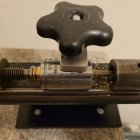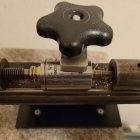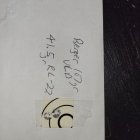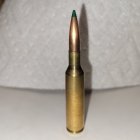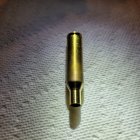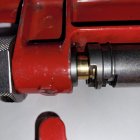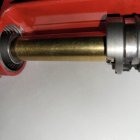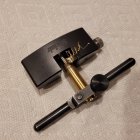For me, one of the best expressions of a " custom " varmint rifle is one that is chambered in a " wildcat " cartridge of your own design. My accuracy rifle interests are dominated by groundhog shooting along with some occasional "groundhog & egg" shoots.
I have never been a " me too " type of guy, so the use of a wildcat taylored specifically to my shooting needs has always made sense.
My first wildcat designed to suit my shooting needs was .35 Remington necked-down to .22" calibre. It was a great chambering
for shooting 55gr varmint bullets out of a 24" 1-14, which proved adequated for a groundhog kill to just past 500yd.
But after developing troubles seeing .224" cal holes in-paper @ 300yd when viewing using a 2X-boosted T-36, I decided I needed to graduate to use of a larger varmint / target calibre to meet my requirements. This was bolstered by the fact I wanted a energy delivery system that would provide clean kills on groundhog out to 1,000yd; or even a bit farther.
My best friend and shooting buddy was/is heavily into short range benchrest, and was encouraging me to go to 6mm for my next wildcat. An all new wildcat design can often be an expensive project to bring to fruition, and my mind began to consider possible use of an exisiting chamber reamer run-in " short ", as a means to meet my project goals; which were:
- Use of wildcat chamber that would provide the necessary capacity to meet my shooting needs. This includes ability of the energy delivery system to put 450ft lbs on a groundhog @ distance.
- I wildcat / case that had not been previously tried in the calibre I was interested in using.
- Availability of quality brass that featured the case' base diam I would need for the new wildcat.
- Neck length and shoulder angle that would keep the powder combustion " turbulence point " located inside the neck.
- I wanted to use a shoulder angle that could be mechanically-formed, and also no " false shoulders " needed for fire forming.
- Ability to use an existing ( 6 mm cartridge ) chamber reamer, to hep control project costs.
- Use of ( non-custom ) off-the-shelf dies for wildcat' case forming, and for loading / re-loading fired cases.
- .308 bolt face compatibility utilizing a " rimless " case, to allow use of the wildcat in my Wichita WBR1375 single shot action.
Those were most of the project goals. I first tried the idea of a fore-shortened 6mm Remington, using chamber' base diameter that would accept .35 Remington brass. That trial 6mm wildcat had case capacity between that of the 6PPC and a 6BR.
That case size was too small in capacity, for my needs. I had drawn up a 6mm wildcat design in Feb 2005, that I provisionally called " 6mm Ideal ", which was to feature what I believed would have nearly the ideal case capacity I had in mind. I knew I did not need .243Win sized case capacity. But, the design was based off .308 brass, which would have kept me from realizing all of my project's goals. Then it hit me....... run the 6mm Remington reamer in a bit deeper than what use of .35 Remington brass required, and use a parent case that featured larger base diam. I very quickly realized that 7 X 64 Brenneke had the base diam of .466" that would give me a 6mm wildcat w/ the case capacity I wanted, and was .308 bolt face compatible " rimless " !
7 X 64 also rather fortuitously has a case taper very compatible w/ what the 6mm Remington features.
This new 6mm wildcat of mine practically designed itself ! All I needed was the riflesmith to hit the base diameter I wanted. In 2D side view of the case's " stacked " dimensions we see: the same neck length.... shoulder angle.... and shoulder diam that 6mm Remington features, use of a " frustrum " of the 6mm Remington cone to obtain the base-to-shoulder dimension; AND... final addition of the extractor groove & rim thickness dimensions which added together give the wildcat's total case oal. Please note: my design math was not working from a point .200" ahead of the rim face, but wath cyphered as stated immediately above.
I borrowed a tight-necked 6mm Remington chamber reamer from a shooter I had met online. I only had to cover cost of 2-way postage . No custom chamber reamer required !
For case forming, I utilize a stock ( LEE ) 6.5 X 55 Swedish FL die that I have removed internals from, to make the die " open topped ". This die has just enough difference in shoulder diam and large enough base diam to allow forming of my DEEP 6 cases
w/o shoulder buckling or sizing of the case' base. To get the parent brass deep enough inside the form die, I use a " perch " assembled using a stock .308 shell holder and a 5/16" 1/4 - 20 shoulder bolt that I epoxy in-place for security. No custom case forming die(s) required to form DEEP 6 cases.
As a necessary adjunct to case forming, I first give all virgin parent brass an annealing. Annealing helps prevent " striations " in the formed shoulders of the wildcat cases. This is important, as DEEP cases are formed utilizing the bottom portion of the 7 X 64 case. That results in final wildcat cases that are very robust.....since their upper case' wall thickness and shoulders are a bit thicker than what one normally sees in factory cartridge chamberings, and is also thicker than is seen in many wildcats. The anneal helps w/ the plastique' qualities of the brass.
Cases to be formed are very slightly lubed, then sat atop the perch.

The press' handle ( Rockchucker ) is operated to advance the brass up into the die.
As the shoulder is shoved farther downward on the case, excess brass extrudes in a " stove pipe " out of the open-topped form die.
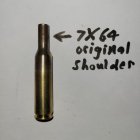
The 26* angle eases mechanical forming of the case' shoulders. Newly formed cases exit the forming die w/ the slightest tap from a punch. Cases emerge from the die in near net shape.
After forming, cases are rough cutoff, then detail trimmed to final case oal desired.

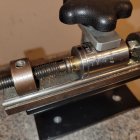
I utilize a stock Wilson 6mm Remington case length gage as my trim guide.

DEEP 6 cases are given an inside neck ream and outside neck turn, to arrive @ final calibre and neck wall thickness desired.
I use a stock Wilson 6mm Remington case holder during case trimming w/ the Wilson lathe.
No custom case holders or gages required to make DEEP 6 cases.
I do also check primer pocket uniformity, and run a flash hole debur tool through all cases. I use Norma brass, and see little if any metal removed during these 2 steps.
My load work initially centered around use of IMR7828 and RL-22. I prefer to shoot high load density when I can. I can completely fill the case w/ 7828 under all 6mm bullet weights of 85 - 107gr, and still have safe pressures. I can very nearly fill the case full of RL-22 under the same 6mm bullet weights, and only have to adjust powder charge .1gr up or down to obtain best accuracy. The group shown is one of my best ones ever .... right until I took the last shot ( I was not using any windflags that range cession ). AAaaack !!!
I have enbraced use of Sierra 95 T-MKs. After reading that RL-22 " burns pretty hot ", my current range testing is a 3-way run-off between loads assembled using RL-23, RL-25; and RL-26. My expectation is that one of these temp insensitive powders will work. I bias obtained accuracy ahead of obtained velocity, and as one result; I have no chrono data to share. I do like using FED Large Magnum Rifle primers. DEEP 6 case capacity is positioned between a 6XC and a 6 Creed, far as I have been able to determine from reading. DEEP 6 then, does have enough case capacity to put 3,000fps on a 105 - 108 6mm VLD, when shot from a 29" barrel.
Fire forming does little other than crisp the shoulders, slightly. I have some DEEP 6 cases w/ over 33 firings on them, and primer pockets are still tight.
I'm really happy w/ how well the project's goals were met, and this approach to wildcatting sure did save me $$$.
I use 450ft lb as my guide for the energy threshold needed for reliable kills on " Soybeanus Digestus " @ distance.
DEEP 6 ( my loads / my gun ) can certainly give me that @ 1,000yd, and even a bit farther out if the situation arises.
*** Please note : I have been limited to placing 6 attachments per post. I will send along additional pics in a second post ***
Please stand by....
With regards,
357Mag
.
I have never been a " me too " type of guy, so the use of a wildcat taylored specifically to my shooting needs has always made sense.
My first wildcat designed to suit my shooting needs was .35 Remington necked-down to .22" calibre. It was a great chambering
for shooting 55gr varmint bullets out of a 24" 1-14, which proved adequated for a groundhog kill to just past 500yd.
But after developing troubles seeing .224" cal holes in-paper @ 300yd when viewing using a 2X-boosted T-36, I decided I needed to graduate to use of a larger varmint / target calibre to meet my requirements. This was bolstered by the fact I wanted a energy delivery system that would provide clean kills on groundhog out to 1,000yd; or even a bit farther.
My best friend and shooting buddy was/is heavily into short range benchrest, and was encouraging me to go to 6mm for my next wildcat. An all new wildcat design can often be an expensive project to bring to fruition, and my mind began to consider possible use of an exisiting chamber reamer run-in " short ", as a means to meet my project goals; which were:
- Use of wildcat chamber that would provide the necessary capacity to meet my shooting needs. This includes ability of the energy delivery system to put 450ft lbs on a groundhog @ distance.
- I wildcat / case that had not been previously tried in the calibre I was interested in using.
- Availability of quality brass that featured the case' base diam I would need for the new wildcat.
- Neck length and shoulder angle that would keep the powder combustion " turbulence point " located inside the neck.
- I wanted to use a shoulder angle that could be mechanically-formed, and also no " false shoulders " needed for fire forming.
- Ability to use an existing ( 6 mm cartridge ) chamber reamer, to hep control project costs.
- Use of ( non-custom ) off-the-shelf dies for wildcat' case forming, and for loading / re-loading fired cases.
- .308 bolt face compatibility utilizing a " rimless " case, to allow use of the wildcat in my Wichita WBR1375 single shot action.
Those were most of the project goals. I first tried the idea of a fore-shortened 6mm Remington, using chamber' base diameter that would accept .35 Remington brass. That trial 6mm wildcat had case capacity between that of the 6PPC and a 6BR.
That case size was too small in capacity, for my needs. I had drawn up a 6mm wildcat design in Feb 2005, that I provisionally called " 6mm Ideal ", which was to feature what I believed would have nearly the ideal case capacity I had in mind. I knew I did not need .243Win sized case capacity. But, the design was based off .308 brass, which would have kept me from realizing all of my project's goals. Then it hit me....... run the 6mm Remington reamer in a bit deeper than what use of .35 Remington brass required, and use a parent case that featured larger base diam. I very quickly realized that 7 X 64 Brenneke had the base diam of .466" that would give me a 6mm wildcat w/ the case capacity I wanted, and was .308 bolt face compatible " rimless " !
7 X 64 also rather fortuitously has a case taper very compatible w/ what the 6mm Remington features.
This new 6mm wildcat of mine practically designed itself ! All I needed was the riflesmith to hit the base diameter I wanted. In 2D side view of the case's " stacked " dimensions we see: the same neck length.... shoulder angle.... and shoulder diam that 6mm Remington features, use of a " frustrum " of the 6mm Remington cone to obtain the base-to-shoulder dimension; AND... final addition of the extractor groove & rim thickness dimensions which added together give the wildcat's total case oal. Please note: my design math was not working from a point .200" ahead of the rim face, but wath cyphered as stated immediately above.
I borrowed a tight-necked 6mm Remington chamber reamer from a shooter I had met online. I only had to cover cost of 2-way postage . No custom chamber reamer required !
For case forming, I utilize a stock ( LEE ) 6.5 X 55 Swedish FL die that I have removed internals from, to make the die " open topped ". This die has just enough difference in shoulder diam and large enough base diam to allow forming of my DEEP 6 cases
w/o shoulder buckling or sizing of the case' base. To get the parent brass deep enough inside the form die, I use a " perch " assembled using a stock .308 shell holder and a 5/16" 1/4 - 20 shoulder bolt that I epoxy in-place for security. No custom case forming die(s) required to form DEEP 6 cases.
As a necessary adjunct to case forming, I first give all virgin parent brass an annealing. Annealing helps prevent " striations " in the formed shoulders of the wildcat cases. This is important, as DEEP cases are formed utilizing the bottom portion of the 7 X 64 case. That results in final wildcat cases that are very robust.....since their upper case' wall thickness and shoulders are a bit thicker than what one normally sees in factory cartridge chamberings, and is also thicker than is seen in many wildcats. The anneal helps w/ the plastique' qualities of the brass.
Cases to be formed are very slightly lubed, then sat atop the perch.

The press' handle ( Rockchucker ) is operated to advance the brass up into the die.
As the shoulder is shoved farther downward on the case, excess brass extrudes in a " stove pipe " out of the open-topped form die.

The 26* angle eases mechanical forming of the case' shoulders. Newly formed cases exit the forming die w/ the slightest tap from a punch. Cases emerge from the die in near net shape.
After forming, cases are rough cutoff, then detail trimmed to final case oal desired.


I utilize a stock Wilson 6mm Remington case length gage as my trim guide.

DEEP 6 cases are given an inside neck ream and outside neck turn, to arrive @ final calibre and neck wall thickness desired.
I use a stock Wilson 6mm Remington case holder during case trimming w/ the Wilson lathe.
No custom case holders or gages required to make DEEP 6 cases.
I do also check primer pocket uniformity, and run a flash hole debur tool through all cases. I use Norma brass, and see little if any metal removed during these 2 steps.
My load work initially centered around use of IMR7828 and RL-22. I prefer to shoot high load density when I can. I can completely fill the case w/ 7828 under all 6mm bullet weights of 85 - 107gr, and still have safe pressures. I can very nearly fill the case full of RL-22 under the same 6mm bullet weights, and only have to adjust powder charge .1gr up or down to obtain best accuracy. The group shown is one of my best ones ever .... right until I took the last shot ( I was not using any windflags that range cession ). AAaaack !!!
I have enbraced use of Sierra 95 T-MKs. After reading that RL-22 " burns pretty hot ", my current range testing is a 3-way run-off between loads assembled using RL-23, RL-25; and RL-26. My expectation is that one of these temp insensitive powders will work. I bias obtained accuracy ahead of obtained velocity, and as one result; I have no chrono data to share. I do like using FED Large Magnum Rifle primers. DEEP 6 case capacity is positioned between a 6XC and a 6 Creed, far as I have been able to determine from reading. DEEP 6 then, does have enough case capacity to put 3,000fps on a 105 - 108 6mm VLD, when shot from a 29" barrel.
Fire forming does little other than crisp the shoulders, slightly. I have some DEEP 6 cases w/ over 33 firings on them, and primer pockets are still tight.
I'm really happy w/ how well the project's goals were met, and this approach to wildcatting sure did save me $$$.
I use 450ft lb as my guide for the energy threshold needed for reliable kills on " Soybeanus Digestus " @ distance.
DEEP 6 ( my loads / my gun ) can certainly give me that @ 1,000yd, and even a bit farther out if the situation arises.
*** Please note : I have been limited to placing 6 attachments per post. I will send along additional pics in a second post ***
Please stand by....
With regards,
357Mag
.










